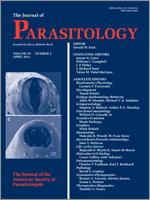The argasid tick Ornithodoros marinkellei Kohls, Clifford, and Jones, 1969 was described 4 decades ago based on larval specimens collected from bats (Pteronotus spp.) in Colombia and Panama. Thereafter, larval O. marinkellei parasitizing bats were reported from Venezuela, Guyana, and Brazil. Herein, we describe the adults and nymph, and redescribe the larva of O. marinkellei based on specimens recently collected in the western Brazilian Amazon region. In contrast to all other known adult argasids, the idiosoma of both males and females of O. marinkellei is covered with sclerotized plaques. The idiosoma of the nymph of O. marinkellei is entirely micromamillated, and differs from the adults by the absence of plaques. The larva of O. marinkellei is morphologically similar to the larvae of the 2 other species belonging to the subgenus Subparmatus, i.e., Ornithodoros viguerasi Cooley and Kohls, 1941 and Ornithodoros mormoops Kohls, Clifford, and Jones, 1969. Because of the long and narrow dorsal plate, the larva of O. marinkellei is readily distinguished from O. viguerasi and O. mormoops. Comparison of our larvae from Brazil with O. marinkellei paratype specimens from Colombia confirmed their taxonomic identification. However, a few morphological differences, particularly in the size of the gnathosoma, were observed. Further studies are necessary to clarify whether O. marinkellei is a complex of different species, or a single species represented by morphologically polymorphic, and geographically distinct populations. Partial mitochondrial 16S rDNA gene sequences were generated for O. marinkellei specimens from Brazil, and compared with available homologous sequences in GenBank. Phylogenetic analyses revealed O. marinkellei to be distinct from the remaining argasid species available in GenBank, including other bat-associated tick species that are found in sympatry with O. marinkellei in the Neotropical region.
How to translate text using browser tools
1 April 2011
Description of Adults and Nymph, and Redescription of the Larva, of Ornithodoros marinkellei (Acari: Argasidae), with Data on Its Phylogenetic Position
Marcelo B. Labruna,
Santiago Nava,
Flavio A. Terassini,
Valeria C. Onofrio,
Darci M. Barros-Battesti,
Luis Marcelo A. Camargo,
Jose Manuel Venzal
ACCESS THE FULL ARTICLE

Journal of Parasitology
Vol. 97 • No. 2
April 2011
Vol. 97 • No. 2
April 2011





